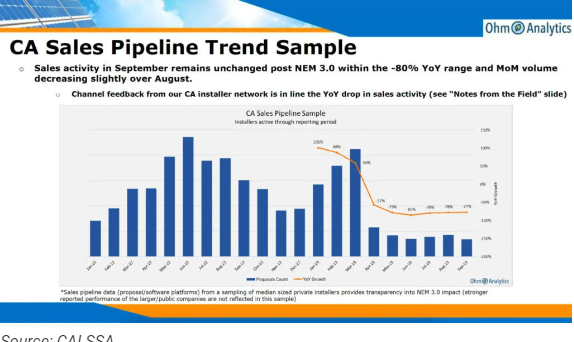66% of California’s Solar Firms Have Cash Flow Issues, Leading to Loss of 17,000 Solar Jobs
Solar installers across the country started reeling from slumping sales as higher interest rates, which makes rooftop solar panels more expensive, started taking hold. When California, the largest US Solar market, and the CPUC implemented NEM 3.0 in April 2023, it exacerbated the problem acutely. During a recent “virtual briefing” hosted by the Environmental Working Group, they blamed Newsom and the CPUC for the decision.
NEM2.0 vs. NEM3.0
We are fortunate that we installed our rooftop solar in 2017, falling under the NEM2.0 rate structure. Our net electric bills are $20/Month, but we have an intentional mixed use energy strategy of Solar, Utility, Propane, wood fireplace and backup generator. I have non solar neighbors that are now, with PG&E’s January 2024 13% rate increase, north of $500/month for electricity. Larger homes will see closer to an 18% increase in their bills due to the tiered rate structure that PG&E uses.
The NEM 3.0 rate plan, scaled back by approximately 70% the amount of money homeowners can earn when they sell energy back to the utility. This makes it more difficult to justify solar as the ROI (return on investment) becomes significantly longer. It is no surprise what happened over the next 9 months.
Largest Ever Clean Energy Job Loss – 17,000 Good Paying Solar Jobs Gone
“Seventeen thousand jobs have been shed as a direct result of this bad policy decision, that was made on behalf of California’s investor-owned utilities.” said Bernadette Del Chiaro, executive director of CALSSA. “CPUC commissioners claimed their decision was about ‘launching the solar and storage industry into the future.’ Instead, they caused the nation’s largest-ever loss of clean energy jobs, pushed once thriving businesses out of the state or into bankruptcy, and derailed California’s fastest and most accessible path to a clean energy future. All as California holds itself out there as a world leader in the fight against climate change,”
The result of unintended consequences is not surprising, with sales dropping an estimated 67% – 85% for California’s private residential installers. The California Solar & Energy Storage Association found 63% of its 400 members reported significant cash flow issues, according to Bernadette Del Chiaro, Executive Director of the group. She further added that 25-30 solar companies have either left the state or closed their business. “We are worried about the next two months,” she said. “We think a lot more fallout may be coming.”
Nationally, more than 100 Solar Companies have gone out of business and the big national players have been reporting significantly worse quarter over quarter numbers for the past year.
Job Cuts and Bankruptcies Extend Across the Industry
Residential Solar Installers are cutting jobs and bankruptcies have been mounting. Companies in the Solar industry are starting to cut jobs as well. Enphase Energy, a Fremont, CA. based supplier of inverters and equipment that converts DC power from solar panels to AC power for the grid, announced in December 2023 that it’s laying off 350 employees, or 10% of its workforce.
Enphase CEO Badri Kothandarama said, “Over the last 12 months, the solar market has experienced significant turbulence worldwide.” In the United States, high interest rates have resulted in a substantial decrease in consumer demand, while California’s NEM 3.0 transition continues to introduce further uncertainty.”
What To Do if Your Solar Company Goes Out of Business
Solar panel systems are a long-term commitment and the typical payback (ROI) used to be around 5 years. These systems should produce energy you can use for approximately 20 years, so if the company that installed the panels on your roof goes bankrupt, you could be left holding the bag. One of the best practices we help our customers do is to have a complete list of equipment used in their energy system.
Include all the major components, including the solar panels, inverters, batteries, transfer switches, generators, smart panels, and breakers. Include model numbers, installation dates, serial numbers and the manufacturers’ contact information. This way, if your installer does go out of business, you can have conversations with potential servicing companies and you are not paying them to come out and inventory your system. We found this informative write-up on what to do if this happens to you.
Try and find a local Solar company that you can get referrals and references for. The local firms are smaller, but they more than likely are not over extended and manage their finances better than the larger national companies, who are expanding through acquisitions and debt financing.
Is Help on the Way?
PG&E has donated well over $10 million to Newsom’s campaigns since his first run for San Francisco supervisor in 1998, so don’t expect much relief from that quarter. One thing that will help buyers of solar panels and systems is that Solar modules are piling up around the world. The glut drove prices down by over 50% in 2023 and that is expected to drop another 40% over the next few years. Associated equipment has also dropped significantly and that bodes well over the short term for both homeowners and installers. But whether that is enough to stave off continued layoffs and bankruptcies across the industry in turmoil remains to be seen.
Stay tuned for more. We are following this closely.
Contact Todd Wulfert – todd@pacificenergyadvisors.com – 415-608-1434








